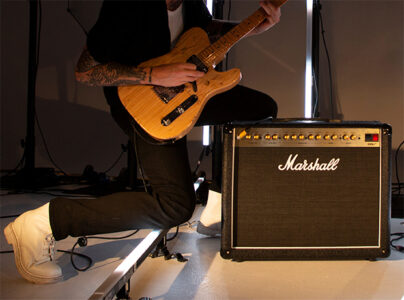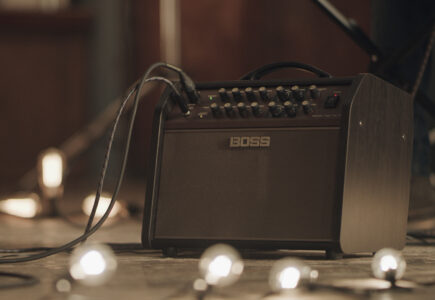You already know what a guitar amplifier is. But did you know that there are different types of amps for electric and acoustic guitars? Want to know why? Read on.
Electric guitar amps
 If you want to make your electric guitar sound like an electric guitar, then having a good amp is about as important as the instrument itself. It’s the amp that takes your clean guitar signal and changes it into the treble-heavy, compressed, and saturated sound that we all know and love.
If you want to make your electric guitar sound like an electric guitar, then having a good amp is about as important as the instrument itself. It’s the amp that takes your clean guitar signal and changes it into the treble-heavy, compressed, and saturated sound that we all know and love.
Electric guitar amplifiers come in a huge range of shapes and sizes and can make use of various technologies – but whether it’s a tube, solid-state, or hybrid guitar amp, the principles are the same.
All these amplifiers are designed to work specifically with the magnetic pickups of an electric guitar.
They produce a tone with a more focused mid-range and reduced definition at the high end. This is largely because overdriven guitar tones feature a lot of harmonic content at the top end of the audible frequency spectrum.
A completely faithful representation of these sounds isn’t massively pleasant to listen to – so the speakers have a mid-ranged focus and roll off the highs.
In essence, these changes cause electric guitar amplifiers to add colour to the signals coming through them.
Acoustic guitar amps
 In contrast, an acoustic guitar amplifier aims to reproduce the exact sound of the instrument as faithfully as possible.
In contrast, an acoustic guitar amplifier aims to reproduce the exact sound of the instrument as faithfully as possible.
Designed to work with the piezo pickups of your electro acoustic (or even with a microphone), these amplifiers have a blank, uncoloured sound with a flat frequency response. This allows them to recreate the subtleties of your instrument’s tone.
They’ll often include a tweeter in addition to the main speaker cone, providing extra fidelity in the high frequency range.
These amps are actually very similar to PA speakers, which are also designed to amplify signals without adding any tonal colour. In fact, acoustic players will often plug straight into a venue’s mixing desk or PA system. However, acoustic guitar amps come with specifically guitarist-friendly features such as built-in effects, equalisation controls, and effects loops.
Many of them also have multiple inputs, allowing you to plug in a microphone and aux cord alongside your guitar. This is perfect for solo musicians who want to control everything from the stage or buskers who need the convenience of having everything in one place.
Do you need both?
Let’s say you’re playing a set where you want to use both an acoustic and an electric guitar. Carrying one amp around is already a massive faff, but two? Short of hiring a roadie, what’s the solution?
You’re probably wondering – can you just play your acoustic guitar through an electric amp (or vice versa)?
The answer is yes – you won’t break anything by doing so – but you might not get the sound you’re looking for.
Acoustic guitar, electric amp
As discussed above, electric guitar amplifiers add colour to the natural tone of whatever’s plugged in by exaggerating the mids and reducing the highs.
If you plug your electro acoustic into something like the Orange Crush (known for its crunchy tones), it’s going to sound a bit like you’re hearing it through an old-school telephone line. Muddy, compressed, and probably breaking up when you play at higher volumes.
There’s nothing wrong with this sound – it might suit you really well if you’re doing something like punk or garage. However, if you’re looking for a clean and unaltered tone, you’ll struggle to get it here.
A slightly better option might be a Fender amp, such as the Tonemaster Deluxe Reverb which is known for having huge amounts of clean headroom and massive dynamic ranges. Plugging into one of these means that you won’t have nearly so much of a problem with breaking up, even when playing at higher volumes – but you’ll still lose clarity in the top frequencies.
The tone you’ll get from this is warmer and more bluesy than the clean sound of an acoustic amp. Again, some people will love this sound, but it might not suit everybody.
 Electric guitar, acoustic amp
Electric guitar, acoustic amp
Plugging your electric guitar into an acoustic amplifier will give you a very clean, dead-sounding tone – especially if you’re using a solid-body, as you’ll have basically no sustain whatsoever. Imagine the sound you get when you DI your guitar. That’s the sound you’ll get from an acoustic amp.
Once again, this isn’t necessarily a bad thing for styles like jazz which require a clear tone, and hollowbody players who keep it clean might find that the increased fidelity at the high end is exactly what they’ve been looking for.
However, if you use effects like distortion and overdrive, there’ll be a lot of unpleasant high-frequency content. And if you’re playing with a band, you’ll struggle to cut through the mix due to the flat frequency response at the end of the signal chain.
Workarounds
If you want a compact rig whilst still using both kinds of guitar, then fear not – there are plenty of solutions available to you.
Amp simulation
One of your best options could be an amp simulator pedal. These are designed to emulate the circuitry of an electric guitar amplifier – and often come with settings for several famous amp tones, all packed into one pedal!
If you run your electric guitar through one of these and then into an acoustic amp, you’ll have rid your signal of those nasty high frequencies and added the warmth and colour your tone was otherwise missing.
Acoustic simulation
Whilst we’re on the subject of pedals, you could consider ditching your acoustic guitar entirely and simply running your electric through an acoustic guitar simulator like the Boss AC-3 or Mooer Acoustikar.
These effects pedals make your electric guitar sound like an acoustic, with settings for different acoustic sound profiles. The Boss model even has a LINE OUT connection, allowing you to send your “acoustic” signal to either an acoustic amp or straight to the PA system – just like you’d want to with a real acoustic guitar.
Using what you’ve got
If you’d prefer to keep your trusty electric amp by your side but still want to use an acoustic guitar in your set, you’ve got a couple of options.
As we discussed before, using a clean tone on an electric amp with your acoustic guitar can work just fine – depending on the sound you’re going for.
If your electric amp has effects loop connections, you could try plugging your acoustic straight into the effects return – as this bypasses the amplifier’s preamp circuitry. This will remove a lot of the tonal colour, giving you a more natural timbre. Keep in mind that you’ll still be lacking some high-frequency content though, as the amp’s speaker is still designed to give that mid-focused output.
Alternatively, almost all venues will have a PA system which you can run your acoustic guitar straight into. Just ask to be plugged into the mixer.
The main thing to remember is that there’s no correct way to run your guitar rig. Never stop yourself from trying things out and seeing what works best for you.

Find out more
Want to do your acoustic guitar justice? Or are you hankering for a new electric tone? Explore our range of electric and acoustic guitar amplifiers – and build the foundation for your perfect guitar rig.













In playing small venues, 40-50 people, can I use an amp for both guitar and vocals? Or will I need a speaker?
Hi Phillip,
Thanks for your message. We suggest using a separate speaker for vocals, this will give you a clearer, high-quality sound. “Level 3” of our Live Sound 101 article: https://www.gear4music.com/blog/live-sound-101-your-ultimate-guide/ goes into more detail on setups for small venues! Hope this helps!
If you’re playing in small venues and max 50 people, with no PA, check the Roland Cube Street EX.